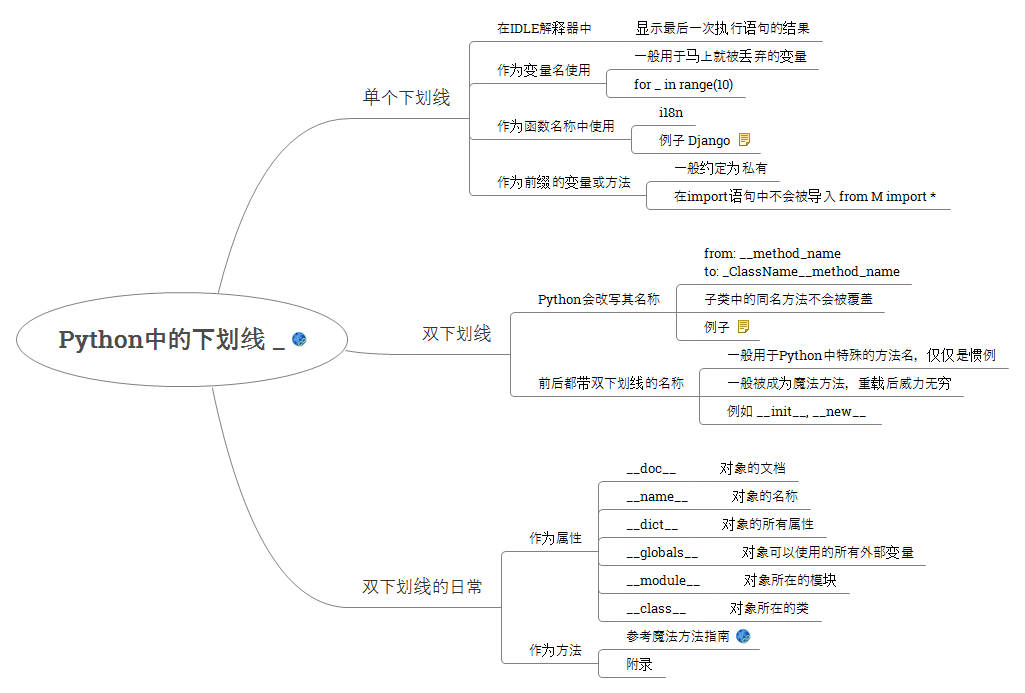下划线在 Python 中有很特别的意义。
开门见山
下划线在 Python 中有特殊的意义,简单来说,可以总结成三点。
- 单下划线在前一般用于声明私有成员,比如
_private_var - 单下划线在后一般用于命名已经被保留关键字占用的变量,比如
class_,type_ - 双下划线一般被用于 Python 内置的特殊方法或者属性,比如
__name__,__file__,有时候也被称之为魔法方法。
更多细节的讨论,可以看 StackOverflow 上的这个主题:What is the meaning of single and double underscore before an object name?。
__foo__: this is just a convention, a way for the Python system to use names that won’t conflict with user names.
_foo: this is just a convention, a way for the programmer to indicate that the variable is private (whatever that means in Python).
__foo: this has real meaning: the interpreter replaces this name with_classname__fooas a way to ensure that the name will not overlap with a similar name in another class.No other form of underscores have meaning in the Python world.
There’s no difference between class, variable, global, etc in these conventions.
有时候我们还能看到就仅仅命名为一个下划线的的变量,这种情况一般是这个变量不重要或者只是一个临时工,连名字都不配拥有。
1
2
for _,value in func(): # 假如func每次会返回两个值,我们只关心第二个值
use(value)
思维导图
下面是思维导图的总结
如何调用魔法方法
一些魔法方法直接和内建函数对应,这种情况下,如何调用它们是显而易见的。这有个附录可以作为调用魔法方法的参考。
| 魔法方法 | 什么时候被调用 | 解释 |
|---|---|---|
__new__(cls [,...]) | instance = MyClass(arg1, arg2) | __new__在实例创建时调用 |
__init__(self [,...]) | instance = MyClass(arg1,arg2) | __init__在实例创建时调用 |
__cmp__(self) | self == other, self > other 等 | 进行比较时调用 |
__pos__(self) | self | 一元加法符号 |
__neg__(self) | -self | 一元减法符号 |
__invert__(self) | ~self | 按位取反 |
__index__(self) | x[self] | 当对象用于索引时 |
__nonzero__(self) | bool(self) | 对象的布尔值 |
__getattr__(self, name) | self.name #name 不存在 | 访问不存在的属性 |
__setattr__(self, name) | self.name = val | 给属性赋值 |
__delattr__(self, name) | del self.name | 删除属性 |
__getattribute__(self,name) | self.name | 访问任意属性 |
__getitem__(self, key) | self[key] | 使用索引访问某个元素 |
__setitem__(self, key) | self[key] = val | 使用索引给某个元素赋值 |
__delitem__(self, key) | del self[key] | 使用索引删除某个对象 |
__iter__(self) | for x in self | 迭代 |
__contains__(self, value) | value in self, value not in self | 使用 in 进行成员测试 |
__call__(self [,...]) | self(args) | “调用”一个实例 |
__enter__(self) | with self as x: | with 声明的上下文管理器 |
__exit__(self, exc, val, trace) | with self as x: | with 声明的上下文管理器 |
__getstate__(self) | pickle.dump(pkl_file, self) | Pickling |
__setstate__(self) | data = pickle.load(pkl_file) | Pickling |
如果你还想了解关于魔法方法的更多细节,那么你一定不能错过:
